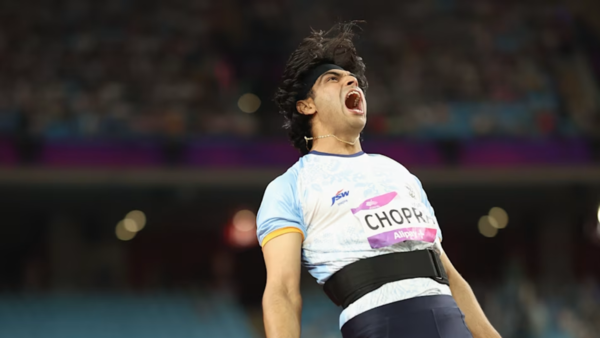“Neeraj Chopra will defend his Olympic title today,” said an official Olympics statement ahead of Chopra’s performance today. “Neeraj Chopra, India’s first Olympic champion in athletics, will defend his crown in the men’s javelin final tonight from 11:55. The reigning world champion left the field in the qualifiers with a magnificent effort of 89.34 meters, the second best of his career,” the statement said.
Neeraj Chopra won gold in javelin at the 2020 Tokyo Olympics.
If he wins gold in Paris, Chopra could become the fifth athlete, first from Asia, to defend the men’s javelin title at the Olympics.
Neeraj Chopra produced the second best performance of his career in the javelin qualifying event at the Paris 2024 Olympics with his record of 89.34m. His best throw is 89.94m in the Diamond League in Sweden on June 30, 2022.
As Neeraj Chopra aims for gold, let’s learn about the fitness routine followed by the 26-year-old. The exercises are intense and meet the demands of javelin throwers.
What went into the preparations for the toss that could give India gold today?
Neeraj Chopra is a fitness enthusiast and is a keen student too, says his fitness trainer Ishaan Marwaha. “He is too intense in training. Whatever is asked of him, he always goes above and beyond. That makes him different from other athletes, you need that dedication level,” he told the media.
His workout routine focuses on improving both upper and lower body strength.
To keep his arms and elbows in good shape, Neeraj focuses on exercising with medicine balls and cable exercises.
Exercises customized for Neeraj
His fitness routine, as detailed in the Olympic portal: There are several exercises that are tailored for Neeraj Chopra. One of them involves him standing tall with his arms above his head holding a heavy ball. Then he gradually begins to kneel and when he is an inch off the ground, he begins to bend backwards with the heavy ball. The body bends again like a bow until the ball is only half an inch off the ground.
When all his body weight is on his toes, he finally throws the ball like a shot. It helps with both strength and flexibility – two essential components for a javelin thrower.

(Photo: Olympics.com)
He also engages his muscles in other types of workouts such as squats, snatches, weight lunges and timed circuits. Dumbbell front and side raises, perpendicular crunches and swiss ball crunches, leg raises also increase his core strength.
After the 2020 Tokyo Olympics, Neeraj was introduced to Tabata training to reduce the weight he had gained. This workout includes HIIT (high-intensity interval) training consisting of 10 different exercises. This cardio workout involves 20 seconds of high-intensity exercise followed by 10-15 seconds of rest.
Ice baths, contrast baths, deep tissue exfoliation and up to 10 hours of sound sleep help the Olympic gold medalist recover from intense training.
Before the Tokyo Olympics, Neeraj had undergone surgery on his throwing arm
Neeraj, then 23, underwent surgery on his throwing arm shortly before the Olympics. After winning gold at the 2018 Commonwealth Games and the 2018 Asian Games, Neeraj Chopra underwent elbow surgery in 2019 and missed major events like the World Championships, Asian Championships and the Diamond League.
Tips for those aiming for a chiseled body
For those men who aspire to have a chiseled physique, Neeraj Chopra’s fitness routine can be a reference, but only after consulting an experienced fitness professional.
Incorporating HIIT into your fitness routine has significant benefits, especially for men in their 30s, 40s, and 50s. HIIT sessions, which alternate between short bursts of intense exercise and periods of recovery, can improve cardiovascular health, improve metabolism and increase fat loss. This effective workout helps maintain muscle mass and reduces the risk of age-related diseases such as diabetes and heart disease. Exercises such as push-ups, push-ups, and bench presses are essential for building and maintaining muscle mass. For men in their 30s, these exercises can help achieve peak physical condition and strength. In your 40s and 50s, upper body strength supports daily activities and prevents muscle loss. Regular upper body training also promotes better posture and reduces the risk of injury.
Pulmonary hypertension: Knowing the important symptoms
It is advisable to take fitness tips from sports people because they have a lot of experience and knowledge in physical training. Their routines are designed to maximize performance, endurance and strength, resulting in effective and efficient fitness advice.
#Neeraj #Chopras #Chiseled #Body #Workout #Men #30s #40s #50s #Times #India